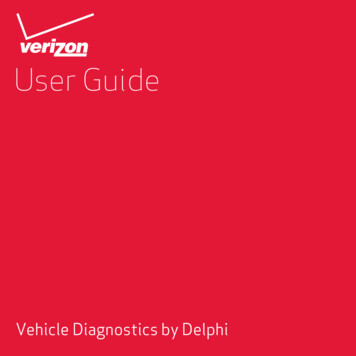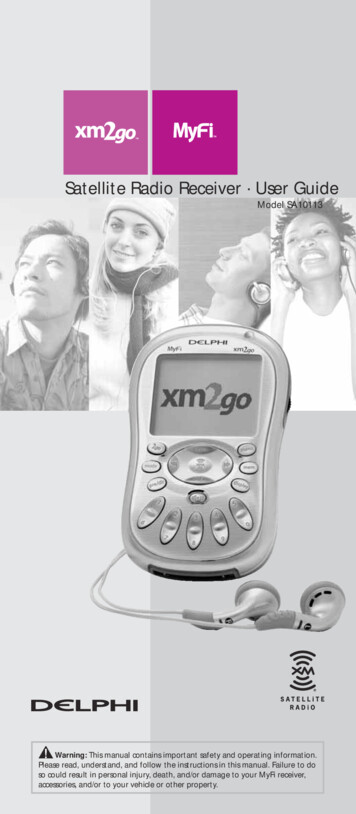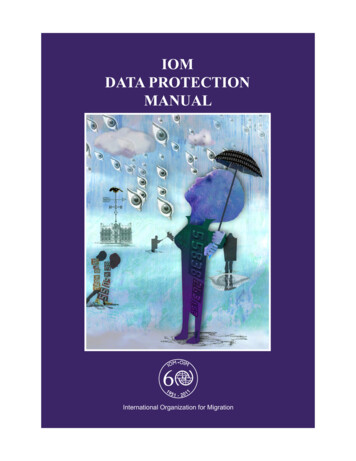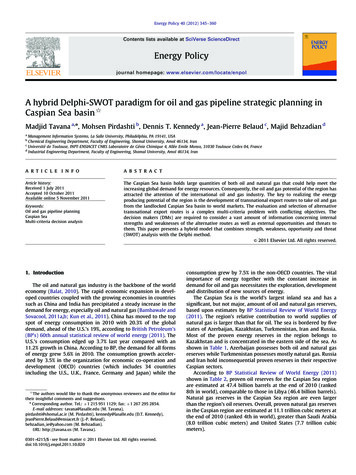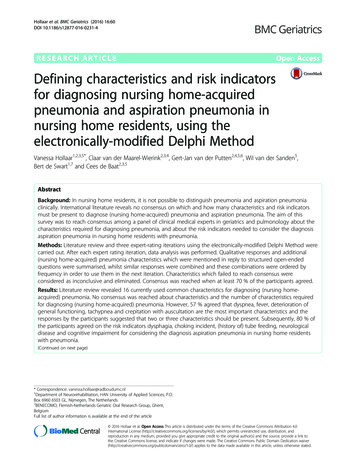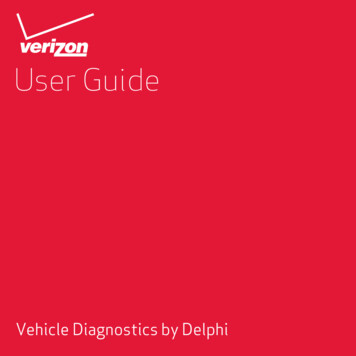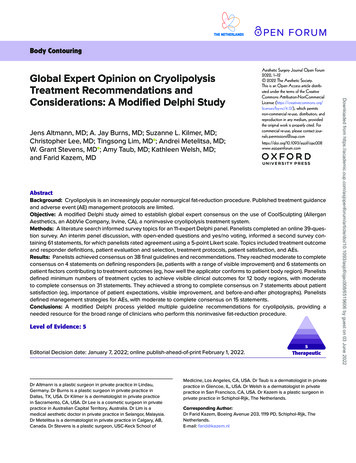
Transcription
Body ContouringJens Altmann, MD; A. Jay Burns, MD; Suzanne L. Kilmer, MD;Christopher Lee, MD; Tingsong Lim, MD ; Andrei Metelitsa, MD;W. Grant Stevens, MD ; Amy Taub, MD; Kathleen Welsh, MD;and Farid Kazem, MDAbstractBackground: Cryolipolysis is an increasingly popular nonsurgical fat-reduction procedure. Published treatment guidanceand adverse event (AE) management protocols are limited.Objective: A modified Delphi study aimed to establish global expert consensus on the use of CoolSculpting (AllerganAesthetics, an AbbVie Company, Irvine, CA), a noninvasive cryolipolysis treatment system.Methods: A literature search informed survey topics for an 11-expert Delphi panel. Panelists completed an online 39-question survey. An interim panel discussion, with open-ended questions and yes/no voting, informed a second survey containing 61 statements, for which panelists rated agreement using a 5-point Likert scale. Topics included treatment outcomeand responder definitions, patient evaluation and selection, treatment protocols, patient satisfaction, and AEs.Results: Panelists achieved consensus on 38 final guidelines and recommendations. They reached moderate to completeconsensus on 4 statements on defining responders (ie, patients with a range of visible improvement) and 6 statements onpatient factors contributing to treatment outcomes (eg, how well the applicator conforms to patient body region). Panelistsdefined minimum numbers of treatment cycles to achieve visible clinical outcomes for 12 body regions, with moderateto complete consensus on 31 statements. They achieved a strong to complete consensus on 7 statements about patientsatisfaction (eg, importance of patient expectations, visible improvement, and before-and-after photographs). Panelistsdefined management strategies for AEs, with moderate to complete consensus on 15 statements.Conclusions: A modified Delphi process yielded multiple guideline recommendations for cryolipolysis, providing aneeded resource for the broad range of clinicians who perform this noninvasive fat-reduction procedure.Level of Evidence: 5Editorial Decision date: January 7, 2022; online publish-ahead-of-print February 1, 2022.Dr Altmann is a plastic surgeon in private practice in Lindau,Germany. Dr Burns is a plastic surgeon in private practice inDallas, TX, USA. Dr Kilmer is a dermatologist in private practicein Sacramento, CA, USA. Dr Lee is a cosmetic surgeon in privatepractice in Australian Capital Territory, Australia. Dr Lim is amedical aesthetic doctor in private practice in Selangor, Malaysia.Dr Metelitsa is a dermatologist in private practice in Calgary, AB,Canada. Dr Stevens is a plastic surgeon, USC-Keck School ofMedicine, Los Angeles, CA, USA. Dr Taub is a dermatologist in privatepractice in Glencoe, IL, USA. Dr Welsh is a dermatologist in privatepractice in San Francisco, CA, USA. Dr Kazem is a plastic surgeon inprivate practice in Schiphol-Rijk, The Netherlands.Corresponding Author:Dr Farid Kazem, Boeing Avenue 203, 1119 PD, Schiphol-Rijk, TheNetherlands.E-mail: farid@kazem.nlDownloaded from 10.1093/asjof/ojac008/6519606 by guest on 03 June 2022Global Expert Opinion on CryolipolysisTreatment Recommendations andConsiderations: A Modified Delphi StudyAesthetic Surgery Journal Open Forum2022, 1–12 2022 The Aesthetic Society.This is an Open Access article distributed under the terms of the CreativeCommons Attribution-NonCommercialLicense (https://creativecommons.org/licenses/by-nc/4.0/), which permitsnon-commercial re-use, distribution, andreproduction in any medium, providedthe original work is properly cited. Forcommercial re-use, please contact 3/asjof/ojac008www.asjopenforum.com
2 METHODSDelphi Process and ParticipantsThe study sponsor recruited 11 global experts in cryoli polysis, including clinicians in the fields of dermatology,plastic surgery, cosmetology, and aesthetics, to participatein a modified Delphi process (Figure 1). The expert panelwas composed of 5 dermatologists (45.5%), 4 plastic surgeons (36.4%), 1 cosmetic doctor (9.1%), and 1 aestheticphysician (9.1%). The experts had an average of 18.5 yearsworking in their current setting, with 10.3 years on averageof CoolSculpting use and experience treating an average33.9 patients per month with the device. Furthermore,only 1 of the 11 experts did not have experience with otherdevices for temperature-based fat reduction, representative of the overall expertise with cryolipolysis. The Delphimethod is an established technique for reaching expertconsensus that uses an initial inquiry to collect data, roundsof questioning, formulation of items for consideration, andreformulation of items to establish an agreement.27 Thisstudy used a modified approach by prespecifying 2 roundsof surveys and predetermining thresholds for reaching anagreement, and by including a non-anonymous, one-time,interim meeting in which experts discussed and rankedtopic items to help drive consensus. The sponsor usedthe services of a third-party scientific consulting agency,Endpoint Outcomes, to manage the Delphi process.Literature SearchThe panel chairperson developed the first round of surveyquestions in coordination with the third-party consultantand the study sponsor. The consultant conducted aMEDLINE literature search in February 2020 for publications in the last 10 years on fat-freezing and cryolipolysisin human adult populations to identify the topics for questions and options for answer choices for the initial survey.The intent of this survey was to capture expert consensuson best practices for patient selection, treatment experience, and AE management with cryolipolysis. The literature included review articles, summary documents,and publications synthesizing information across othersources, covering treatment procedure standards, patientselection criteria, and/or methods for assessing treatmentefficacy and/or AE management; excluded from consideration were animal and pediatric studies, commentaries onother articles, publications about clinical trials and otherspecific studies, and publications lacking abstracts.Survey Development, Administration,and DiscussionThe 11 panelists completed the first-round survey, whichconsisted of 39 free-response and multiple-choice questions and was distributed through email and administeredelectronically using SurveyMonkey (San Mateo, CA). Thesurvey had 7 sections: panelist demographics, definingcryolipolysis outcomes, patient evaluation and selection,treatment protocols for each body region being treated,management of patient satisfaction, AE management, andDownloaded from 10.1093/asjof/ojac008/6519606 by guest on 03 June 2022The number of nonsurgical fat-reduction procedures hasbeen increasing annually.1,2 Individuals may favor noninvasive procedures over surgical methods to reduce excessfat, as surgery may involve anesthesiologic risks, infections, pain, reoperations, scars, downtime, and bleeding.3According to the Aesthetic Society’s Aesthetic PlasticSurgery National Databank, nonsurgical fat-reduction procedures totaled 140,314 in 2020 and were among the top5 nonsurgical procedures performed in 2019.1,2Cryolipolysis (CoolSculpting; Allergan Aesthetics, anAbbVie Company, Irvine, CA, USA) is a nonsurgical andnoninvasive procedure that freezes subcutaneous fatcells through the application of slow, intense, controlledcooling, after which these cells undergo apoptosis andelimination from the body.4-6 It is increasingly sought as analternative to surgical fat-removal procedures because itmay produce high patient-satisfaction levels without thesame risks and recovery time.3,7-14CoolSculpting received initial US Food and DrugAdministration approval in 2010 for fat reduction in theflanks and abdomen.12,15 CoolSculpting is cleared for fatlayer reduction through cold-assisted lipolysis in Europe,Canada, Australia, and Malaysia. In the United States, itis currently indicated for the treatment of fatty areas inthe flanks, abdomen, thighs, submental and submandibular regions, bra strap region, back, underneath thebuttocks, and upper arms.4,15,16 Clinical knowledge andtechnical understanding of cryolipolysis are still developing. Product labeling and existing literature provide limited technical direction and treatment guidance.7,16-19 Theliterature lacks comprehensive direction on techniquesto ensure symmetrical outcomes in particular body areas,achieve optimal placement of the cooling applicatorsto target fat layers, improve procedural time, screen patients for treatment, identify responders, and develop effective protocols for optimal numbers of treatment cyclesand sessions, follow-up periods, durations between treatment sessions, patient satisfaction, and adverse event(AE) prevention and management.20 The authors of thispublication sought to provide expert consensus guidance for defining CoolSculpting treatment outcomes andresponders, understanding patient selection and evaluation criteria, establishing treatment protocols, addressingpatient satisfaction, managing AEs, and decision makingon cryolipolysis as a treatment modality.7,20-26 A modifiedDelphi approach was the selected study method. Theseare the first expert consensus recommendations oncryolipolysis to be published in the literature.Aesthetic Surgery Journal Open Forum
Altmann et al 3selecting cryolipolysis as a treatment modality. Responseoptions for the multiple-choice questions were generatedfrom the literature review and panel chairperson feedback.Response options for multiple-choice questions includeddrop-down numerical responses, scale-based choices(such as not important, somewhat important, and veryimportant), and an “Other [please specify]” option for original responses if existing options did not apply or reflectpanelists’ opinions or experience. The survey was closedafter completion by all panelists, and panelists’ responseswere collated and analyzed. To determine if consensuswas met, the frequency with which the responses were reported was calculated from the total number of panelists(N 11), with a minimum of 7 endorsements (63.6%) as thethreshold for consensus. The responses to open-endedquestions and any “Other” responses were merged, whenpossible, using qualitative coding methods and operationalized using ATLAS.ti version 8.0 or higher (ATLAS.tiGmbH, Berlin, Germany). Original responses deemed relevant by the study group were developed into statementsto be voted on for endorsement by the panel during thesecond survey.The panelists then participated in a virtual interimmeeting that included open-ended discussion and yes/no voting on questions pertaining to the results of the firstsurvey. After the panelists were polled on these questions, they viewed the results of their votes on screenand discussed the findings. This discussion informed thedevelopment of topics, questions, and response optionsfor a second survey. The goal of the second survey wasto achieve consensus on all outstanding topics from thefirst survey and interim discussion. The second survey,also administered electronically through SurveyMonkeyto the 11 panelists, consisted of 61 statements designed todrive consensus and generate treatment guidelines andTable 1. Predetermined Thresholds to Evaluate Consensus inCryolipolysis Delphi PanelStrength of consensusThreshold for percent and number ofpanelists (of 11 Total)Complete100% (11)Strong81.8% to 90.9% (9-10)Moderate63.6% to 72.7% (7-8)Consensus not achieved0% to 54.5% (0-6)recommendations related to cryolipolysis. Panelists ratedtheir level of agreement with 60 of these statements usinga 5-point Likert-type scale (strongly disagree, disagree,neither agree nor disagree, agree, and strongly agree).Consensus MethodologyWhen completing both surveys and considering questions during the interim discussion, panelists were askedto consider their overall experience with cryolipolysis—ie,to approach questions from the perspective of treatmentexperience with about 80% of their patients. To achieveconsensus, endorsements were required from a minimum of 7 panelists; Table 1 summarizes the full criteria forestablishing consensus.RESULTSLiterature ReviewThe literature search generated 104 articles, and the studysponsor provided an additional 23 references. All articles were reviewed for relevance, and 23 were ultimatelyDownloaded from 10.1093/asjof/ojac008/6519606 by guest on 03 June 2022Figure 1. Modified Delphi process.
4 First-Round SurveyA consultant drafted the first-round survey questions andresponse options with input from the sponsor, and theDelphi panel chairperson modified and approved thequestions and response options. The questions addressedlimitations and clinical concerns identified in the literature,such as which body areas can be treated together in thesame session; pretreatment and posttreatment routines;activities that should be avoided before treatment; criteriafor screening patients to receive treatment; and factorsthat impact patient satisfaction, including comfort duringtreatment, cost, downtime, treatment duration, pain tolerance, patient expectations, visibility of improvement, andimmediacy of treatment.The literature review revealed that treatment sessionsconsisted of overlapping treatment cycles and could involve treatment of multiple body areas. Thus, survey questions and meeting discussions used the terms “treatment”and “treatment session” respectively, defined by the chairperson as the “attachment and run of a single applicatoron body area for a prescribed duration” and “a single visitduring which one or more treatment cycles are delivered.”It is important to note that during a review of the final list ofguidelines and recommendations after the second-roundsurvey, it was determined and emphasized that the term“treatment cycles” should be used instead of treatments,and the language in this report aligns with the preferredterminology.Survey questions and meeting discussions also referred to AEs identified in the literature as those that impacted treatment, required intervention, or limited patientsatisfaction with cryolipolysis, including paradoxical adipose hyperplasia (PAH), lip paresis, severe pain, late-onsetpain, frostbite, necrosis, increased sensitivity, and nodularinfiltration.12,28-30During the first-round survey, panelists achieved consensus regarding the management of patient satisfaction,without further discussion needed. Panelists reached astrong to complete consensus on 7 statements, includingthat patient comfort during the procedure has a moderateimpact on satisfaction, whereas improvement that is visible to the patient and aligns with patient expectations hasa significant impact. The panelists agreed that additionaltreatment cycles are an option for patients not satisfiedwith the initial cryolipolysis treatment. They also stronglyrecommended that clinicians capture standardized, clinical before-and-after photographs, which can aid in theirpatients’ recognition of “visible clinical improvement”and thereby enhance patient satisfaction with treatment.Panelists also emphasized that well-defined fat pocketsare more commonly associated with more successful clinical treatment outcomes, as the treatment area is morevisible; that cryolipolysis has limitations in improving otheraesthetic conditions; and that continuous fat pads requireadditional procedure-related considerations to achieve asuccessful treatment outcome.Interim Discussion and Second-RoundSurvey OutcomesThe interim discussion took place on November 7, 2020,and was attended by 10 of the panelists (1 panelist wasabsent due to a scheduling conflict). In total, 38 summarystatements were generated as a final list of guidelinesand recommendations (Table 2). Guidelines and recommendations were derived from the modified Delphi process utilizing the panel’s expert opinions based on theircollective clinical experience. Concerning defining treatment outcomes, the panelists categorized different tiersof responders and how best to assess patients in each ofthese categories, achieving moderate to complete consensus on 4 statements. Panelists agreed on the definitionof treatment “responders” as patients who can experiencea range of visible improvement, and within this category,“poor responders” as patients who require reassessmentor modification of the original treatment plan to demonstrate visible improvement. In contrast, “nonresponders”were defined as a small number of patients who experience no biological response to cryolipolysis treatment(Table 2).Concerning patient evaluation and selection, the panelists established how specific patient factors contributeto treatment outcomes (the most important driver beinghow well the applicator conforms to the body region beingtreated), achieving moderate to complete consensus on 6statements (Table 2). On treatment protocols, the panelists defined the most feasible/ideal number of treatmentcycles for each of the 12 body regions to achieve a clinicalvisible outcome (Table 3). The panel arrived at the recommended numbers of treatment cycles by indicating theirlevel of agreement with statements in the first survey ontreatment cycles and body regions, discussing these results, voting on more specific statements about averagenumbers of cycles per body region, and summarizingDownloaded from 10.1093/asjof/ojac008/6519606 by guest on 03 June 2022included and informed the development of the initialsurvey. A key finding of the literature review was that theterms “responders” and “nonresponders” were used frequently without guidelines on the criteria for categorizingpatients as such. Furthermore, the literature review revealed a lack of published recommendations on measurement techniques for defining outcomes, real-world rangesof cycles per body region, guidance for addressing problems that arise during the procedure, and pre- and postpatient routines and follow-up. No articles recommendeda preferred time between treatment sessions or for a treatment follow-up interval.Aesthetic Surgery Journal Open Forum
Altmann et al 5Table 2. Summary of Final Guidelines and RecommendationsGuidelines and recommendation statementsSubtopic statementsStrength of consensusaDefining outcomes1. The term “nonresponder” should be used only to describe a smallnumber of patients who experience no biological response tocryolipolysis treatment.3. Most patients who experience little to no visible response afterinitial treatment with cryolipolysis would not be considered“nonresponders,” as they would likely respond (either with a visibleresponse or measured by ultrasound scan/caliper measurements)to additional treatment.Patients can experience a range of visible improvementCompleteA “poor responder” will require reassessment ormodification of the original treatment plan to demonstrate visible improvement. This may include additional treatment cycles or alternative treatments.StrongModeratePatient evaluation and selection4. Once a patient has been deemed a candidate for cryolipolysistreatment, a patient’s BMI is generally not a driving factor in determining treatment outcomes but is simply just important to patientselection (ie, patients who fall outside of the current BMI guidelinesfor cryolipolysis treatment should not be considered candidates fortreatment).Completeb5. Although fat thickness and fat firmness play a role in impactingtreatment outcomes, the more important driver of treatment outcomes is whether the applicator can be applied to the area (eg, willthe fat fit in the applicator).Completeb6. Cryolipolysis has limitations concerning targeting all aspects ofaesthetic appearance—consideration of scars, cellulite, and stretchmarks in the treatment area is important as they can impact treatment outcomes.Complete7. Well-defined fat pockets are more commonly associated with moresuccessful clinical treatment outcomes.Complete8. Continuous fat pads require additional procedure-related considerations (eg, overlapping applicators, multiple treatments, and selection of most appropriately sized applicator).Complete9. Men typically present with more fibrous tissue and can have lessvisible results due to challenges in administering the treatment (eg,applicator fit).Moderate10. Gender affects treatment area selection.ModerateTreatment protocols by body region11. For body regions that require multiple treatments of the same area,the number of sessions to complete the treatment plan is based onfeasibility factors such as: Number of cryolipolysis devices at a clinic, Patient’s availability, and/or Patient preference.Complete12. Each patient requires a full body assessment before andthroughout a treatment plan, and therefore any body regions maybe appropriate for treatment and/or assessment together.Complete13. Numbers of treatments typically needed to achieve aclinical visible outcome for specific body regionsare summarized in Table 3.Downloaded from 10.1093/asjof/ojac008/6519606 by guest on 03 June 20222. Within the category of “responder,” patients can experience arange of visible improvement, and a “poor responder” will requirereassessment or modification of the original treatment plan to demonstrate visible improvement. This may include additional treatmentcycles or alternative treatments.Complete
6 Aesthetic Surgery Journal Open ForumTable 2. ContinuedGuidelines and recommendation statementsSubtopic statements14. Multiple treatments would likely result in a more visible and clinically successful outcome than one treatment alone.Strength of consensusaCompleteStrong16. After completion of a patient’s planned final treatment, cliniciansshould typically wait approximately 8 weeks before assessing theoverall outcome of the treatment plan.Strong17. When using a vacuum applicator, if a pop-off event occurs with 5minutes or less remaining in a treatment, the treatment can be considered a complete therapeutic treatment.Strong18. When using a surface applicator (eg, CoolSmooth Pro [ZELTIQAesthetics, Allergan Aesthetics, an AbbVie Company, Irvine, CA]), ifa pop-off event occurs with 10 minutes or less remaining in a treatment, the treatment can be considered a complete therapeutictreatment.Strong19. If a thermal event is detected, the need for additional cryolipolysistreatment, if deemed appropriate, should be assessed the nextday or after (at least 24 hours after the thermal event).Strong20. Postprocedural massage is typically recommended after finishinga cryolipolysis treatment and/or session. Discussing side effectsa patient may be experiencing and appropriate patient educationand self-care recommendations are also suggested.Postprocedural massageStrongDiscussion of current side effectsModeratePatient education and self-care recommendationsModerate21. Time between treatment sessions may vary depending on thebody area being treated and the type of fat in that area. Typically,a longer time between treatment sessions may be needed whendelivering treatments to the thighs or to areas with more fibrousfat.22. Best practices for preventing procedural problems (eg, pop-off,thermal event) are to: Ensure appropriate applicator selection and placement. Ensure the patient is comfortable and appropriately positionedduring treatment. Ensure proper strap placement during treatment. Ensure patient compliance with treatment instructions. Ensure proper cleaning of site before treatment. Ensure proper gel pad placement at the time of treatment. Ensure all staff administering treatment have received theproper training.ModerateEnsure all staff administering treatment havereceived the proper training.CompleteEnsure appropriate applicator selection andplacement.CompleteEnsure the patient is comfortable and appropriatelypositioned during treatment.CompleteEnsure proper strap placement during treatment.StrongEnsure patient compliance with treatmentinstructions.StrongEnsure proper cleaning of site before treatment.StrongEnsure proper gel pad placement at the time oftreatment.StrongManagement of patient satisfaction23. Additional treatment cycles are a follow-up option available topatients if they are not satisfied with the result of cryolipolysistreatment due to suboptimal treatment outcomes.24. Visibility of improvement and patient expectations are factors thatsignificantly impact patient satisfaction with treatment outcomes.25. Patient comfort during treatment moderately impacts patient satisfaction with treatment outcomes.AE management (statements 27-36; summarized in Table 4)CompleteVisibility of improvementCompletePatient expectationsStrongStrongDownloaded from 10.1093/asjof/ojac008/6519606 by guest on 03 June 202215. When multiple sessions are needed, time between treatments maytypically range between 4 and 8 weeks.
Altmann et al 7Table 2. ContinuedGuidelines and recommendation statementsSubtopic statementsStrength of consensusaNoninvasiveCompleteMinimal downtimeCompleteEvidence supported by clinical trialsStrongMinimal discomfort during treatment cycleStrongSafety profileStrongAcceptable treatment durationStrongHigh patient satisfactionStrongHigh versatility (ie, ability to treat multiplebody regions)StrongReproducible resultsStrongClinically successful treatment outcomesModerateSelection of cryolipolysis modality38. The most notable parameters that differentiate the CoolSculptingdevice from other cryolipolysis devices include:a. Its established safety,b. It is well supported by research and clinical trial evidence,c. It has results that are reproducible,d. Greater overall treatment efficacy, ande. It can be used with a wide variety of applicators.CompleteaAmoderate consensus rating indicates that 7-8 panelists (63.6% to 72.7%) endorsed a given response, whereas a strong rating indicates that 9-10 panelists (81.8%to 90.9%) endorsed a given response. A complete consensus rating indicates that all 11 panelists endorsed a given response. Consensus was considered not met forrecommendations in which 6 or fewer panelists provided endorsement. bBased on the interim discussion (no additional exploration during the round 2 survey deemednecessary). AE, adverse event; BMI, body mass index.recommendations according to the calculated averagenumber of total treatments in an overall treatment planplus and minus 1 (eg, if the average number of treatmentsindicated in round 1 was 3, the range included in round 2would be 2-4). The panelists agreed that, in general, bodyregions that are larger in size, such as the back and upperabdomen, typically require a greater number of treatmentcycles (range, 3-5); most other body regions typically require fewer treatment cycles (range, 2-4). However, rangesof treatment cycles also depend on the bilaterality of bodyregions—ie, the clinician should ask: Do both the left andright sides of a specific body region on the patient requirethe same number of treatments to achieve a symmetricaloutcome? Panelists also agreed that each patient requiresa full body assessment before and throughout a treatment plan, and any region of the body may be appropriatefor treatment and/or assessment together depending onthe outcome of the assessment. The panel establishedthat “total body assessment” is a method for identifyingan appropriate body region or combination of regions fortreatment. Multiple treatment sessions will likely result ina more successful treatment outcome, and when multiplesessions are needed, time between treatment may rangebetween 4 and 8 weeks. In total, moderate to completeconsensus on 31 statements related to treatment cyclesper body region was achieved (Table 2).The panelists cautioned that the recommended treatment cycles per body region are not based on “treatmentto transformation” or achieving “liposuction-like results,”but rather on the minimums required for an initial visibleclinical outcome, and also noted that more cycles may berequired to achieve optimal results. Certain regions, suchas the abdomen, are highly variable between patientsdepending on body size, and clinicians may have differentapproaches to them—ie, they may or may not segmentthe region into individual treatment areas and may needto administer different numbers of treatment cycles and/orapply different-sized applicators to each side of a region toachieve symmetry (Table 2).The panelists produced recommendations for times between treatment sessions and between the final treatmentand overall outcome assessments as well as best practices for postprocedural routines and procedural problems(Table 2).Related to AE management and prevention, not all of thepanelists were able to share their experience with everyDownloaded from 10.1093/asjof/ojac008/6519606 by guest on 03 June 202237. Advantages of using cryolipolysis as a modality of choice for fat reduction include that the treatment is noninvasive, there is minimaldowntime following the procedure, there is evidence supportedby clinical trials, there is minimal discomfort during the treatmentcycle, the treatment has a strong safety profile, there is an acceptable treatment duration, high patient satisfaction, high versatility(ie, ability to treat multiple body regions), reproducible results, andclinically successful treatment outcomes.
8 Aesthetic Surgery Journal Open ForumTable 3. Number of Typical Treatment Cycles Recommended to Achieve Clinical Visible OutcomeRecommended number of treatment cyclesStrength of consensusaOuter thighs (inclusive of left andright)2-4CompleteMid-abdomen2-4CompleteBody region2-4Complete1-3StrongBanana rolls (fatty areas under buttocks; inclusive of left a
and adverse event (AE) management protocols are limited. Objective: A modied Delphi study aimed to establish global expert consensus on the use of CoolSculpting (Allergan Aesthetics, an AbbVie Company, Irvine, CA), a noninvasive cryolipolysis treatment system. Methods: A literature search informed survey topics for an 11-expert Delphi panel.
